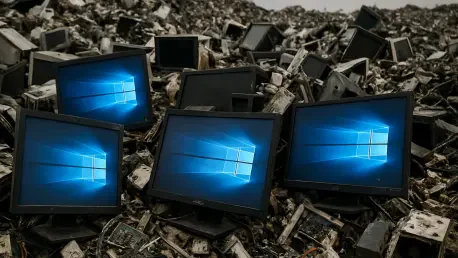What happens when a tech titan like Microsoft pulls the plug on an operating system that still powers nearly 40% of Windows devices globally? The decision to end support for Windows 10 has unleashed a cascade of consequences, threatening to bury the planet under a mountain of electronic waste while leaving millions of users exposed to cyber dangers. This isn’t just a software update issue—it’s a global challenge touching on sustainability, security, and corporate responsibility. Dive into the depths of this crisis, where discarded devices and digital vulnerabilities collide.
The Stakes Couldn’t Be Higher
Microsoft’s move to discontinue Windows 10 support affects a staggering number of users worldwide, many of whom find themselves trapped by the stringent hardware demands of Windows 11. With an estimated 240 million devices at risk of becoming obsolete, the environmental impact looms large as discarded electronics pile up in landfills. Beyond the physical waste, unsupported systems face heightened cybersecurity risks, turning personal data into low-hanging fruit for hackers. This dual threat of e-waste and digital insecurity underscores why this decision resonates far beyond a mere software lifecycle end.
A Deluge of Discarded Tech
The environmental fallout from this policy shift paints a grim picture. As millions of devices fail to meet Windows 11’s requirements, users may have no choice but to abandon perfectly functional hardware. Experts predict this could contribute significantly to the global e-waste crisis, with electronics releasing methane—a greenhouse gas far more potent than carbon dioxide—into the atmosphere as they decompose. The energy-intensive process of manufacturing replacement devices further compounds the problem, driving up carbon emissions through mining and production.
Moreover, the concept of planned obsolescence comes under sharp scrutiny here. Critics argue that tech companies design products with intentionally short lifespans to fuel constant upgrades, a strategy that benefits profit margins at the expense of the planet. This cycle of consumption and disposal raises pressing questions about how the industry can balance innovation with sustainability, especially when such a massive volume of hardware faces premature retirement.
Cybersecurity: A Ticking Time Bomb
On the digital front, the risks are just as alarming. Once Microsoft halts updates for Windows 10 after a brief one-year grace period, systems will be left defenseless against emerging threats. Cybersecurity specialists warn that unpatched vulnerabilities will make these devices prime targets for phishing scams, ransomware, and data breaches, potentially costing users millions in financial losses.
The economic barrier to upgrading adds another layer of concern. With new devices ranging from $300 to over $2,500, many individuals and small businesses simply cannot afford the switch. This leaves a significant portion of the user base stuck with outdated software, creating fertile ground for cybercriminals to exploit weaknesses and wreak havoc on personal and professional lives.
Expert Alarm Bells Ring Loud
Voices from academia are sounding a dire warning about the implications of this decision. Cindy Lin, an Assistant Professor at Georgia Tech’s School of Interactive Computing, criticizes the tech industry’s reliance on planned obsolescence, calling it a deliberate tactic to drive waste and consumption. “This isn’t just about software—it’s about designing systems to fail early, forcing users into a cycle of buying new products,” Lin notes, highlighting the environmental toll of such practices.
Meanwhile, Mustaque Ahamad, a Regents’ Entrepreneur Professor in Cybersecurity and Privacy at Georgia Tech, focuses on the digital dangers. “Unsupported Windows 10 devices will be easy targets for hackers,” Ahamad cautions, predicting a surge in data breaches as cyber attackers exploit unpatched flaws. These expert insights paint a stark picture, blending environmental and security concerns into a unified call for urgent action from both users and policymakers.
Charting a Path Through the Crisis
Amid the looming challenges, viable solutions exist for users caught in this bind. One practical option is transitioning to Linux Mint, a free and open-source operating system that can revive older hardware with minimal requirements—just 2GB of RAM and 20GB of disk space. Equipped with robust security features and a user-friendly interface, it offers a sustainable alternative to discarding devices or risking cyber threats.
On a broader scale, the right-to-repair movement gains traction as a countermeasure to forced obsolescence. By advocating for laws that allow consumers to fix their own devices without legal barriers, this initiative challenges the throwaway culture perpetuated by tech giants. Supporting such policies can pressure companies to prioritize longevity and sustainability, reshaping how technology lifecycles are managed.
Additionally, holding corporations accountable through public advocacy and policy reform remains crucial. Pushing for regulations that incentivize eco-friendly design and extended software support could mitigate future crises of this nature. These combined efforts empower individuals to reclaim control over their tech while urging the industry to adopt more responsible practices.
Reflecting on a Path Forward
Looking back, the decision to end Windows 10 support revealed deep flaws in how technology evolves at the intersection of profit and responsibility. The crisis forced a reckoning with the environmental damage caused by e-waste and the personal risks of cybersecurity gaps. Yet, it also illuminated pathways for change. Users adapted by exploring alternatives like Linux Mint, while advocates amplified calls for right-to-repair laws to extend device lifespans. Moving ahead, the focus must shift to collaborative action—encouraging tech companies to design with sustainability in mind and supporting policies that protect both the planet and digital safety. This moment served as a wake-up call, and the next steps lie in building a tech ecosystem that values endurance over obsolescence.









